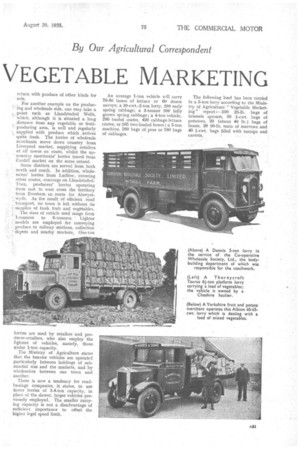Road Transport Indispensable in
Page 36

Page 37

If you've noticed an error in this article please click here to report it so we can fix it.
FRUIT and
VEGETABLE MARKETING
THE organization of fruit and vegetable transport by road is one of the triumphs of the motor age. By no other means could produce be dealt with so effectively. In the producing areas it is essential and its use is extensive, as is the case at the consuming end of the chain, to say nothing of the part played at intermediate points, at the markets and in the wholesale trade.
Road mechanical transport has made it possible to increase production and to sell commodities effectively, because it places larger supplies of fresh produce of first-class quality at the disposal of retailers. The public likes it and asks for more.
Formerly retailers in towns situated at a distance from the producing areas experienced difficulty in securing really fresh vegetables. Similarly, land otherwise suitable for growing fruit and vegetables could not be put under such crops if it were not fairly near to a railway. The result of using road transport is that more land is under, vegetable and. fruit crops than ever before. By the use of the mOtor, lorry, , produce 'gathered one evening can he on the housewife's meal table the next day, almost as fresh ,aS when gathered. . . _ .. .
Since 1918the progress .1-nada in the development,. of road transport in the
fruit and vegetable trade, both on the , .
producing and the distributive sides, has been prodigious. In addition to the direct Use `to Which the motor is put in dealing with prodtice, 'it Plays B30 a great -part in railway transport at each end of the rail journey.
Many methods of dealing with produce are employed. Many transpOrt concerns, some of them owning large fleets, maintain direct services between large growers and the leading markets or wholesalers. Others use light lorries to collect from growers, assembling the produce at 'their own depots and dealing with it in their own way.
The extent and diffusion of road transport in this business are wide, and it is intensively, as well as extensively, used in connection with produce for London, especially in conveying vegetables from Bedfordshire. Special services are operated during the season for the conveyance of asparagus from Badsey and Evesham to London and for mushrooms from different parts. ,
According to the Ministry of Agri-. culture, the use of motors for carrying peas from the Leeds district to Liver:: pool, a distance of about 30 miles,. ia• extensive ; from the Chatreris area tor' Sandy, about 30 mileS, arid for load-,' ing on to the railway for transport by express goods-service to Scotland. For about 20per cent. of the peas .distri, buted from 'the Selby district of 'Yorkshire, and of cabbage from Lancashire, to the consuming areas; 30 per cent. of the vegetables purchased at Pershore ; 20-30 per cent. of the vegetables arriving in Birmingham, and for the bulk of produce grown in the. Tamworth area of Staffordshire for Birmingham and other markets, motor vehicles are used, empties being conveyed on the return journeys.
As is well known, wholesalers rely largely upon road transport for supplying retailers. The Ministry of Agriculture states that Bournemouth Merchants distribute by road a large per centage of the vegetables that they sell. In a scattered area the distance thus covered in a day may be considerable; one Midland wholesaler distributes to retailers within an area of 50 miles from his headquarters. Wholesalers who distribute vegetables at a distance may return with produce of other kinds for sale.
For another example on the producing and wholesale side, one may take a point such as Llandrindod Wells, which, although it is situated a long distance from any vegetable or fruitproducing area, is well and regularly supplied with produce which arrives quite fresh. The lorries of wholesale merchants move down country from Liverpool market, supplying retailers at all towns en route, whilst the upcountry merchants' lorries travel from Cardiff market on the same errand.
Some districts are served from both north and south. In addition, wholesalers' lorries from Ludlow, covering other routes, converge on Llandrindod. Then, producers' lorries operating from east to west cross the territory from Evesham en route for Aberystwyth. As the result of efficient road transport, no town is left without its supplies of fresh fruit and vegetables.
The sizes of vehicle used range from 1-tonners to 6-tonners. Lighter models are employed for conveying produce to railway stations, collection ' depots and nearby markets: One-ton
lorries are used by retailers and producer-retailers, who also employ the lightest of vehicles, namely, those under 1-ton capacity.
The Ministry of Agriculture states that the heavier vehicles are operated particularly between holdings of substantial size and the markets, and by wholesalers between one town and another.
There is now a tendency for roadhaulage companies, it states, to use faster lorries of 3-4-ton capacity, in place of the slower, larger vehicles previously employed. The smaller carrying capacity is not a disadvantage of sufficient importance to offset the higher legal speed limit. An average 1-ton vehicle will carry 70-80 boxes of lettuce or 60 dozen savoys; a 30-cwt.-2-ton lorry, 200 early spring cabbage; a 3-tormer 200 fully grown spring cabbage ; a 4-ton vehicle, 280 bushel crates, 420 cabbage-lettuce crates, or 165 two-bushel boxes ; a 5-ton machine, 280 bags of peas or 180 bags of cabbages. The following load has been carried in a 5-ton lorry according to the Ministry of Agriculture "Vegetable Marketing" report :-100 28-lb. bags of brussels sprouts, 30 1-cwt. bags of potatoes, 20 (about 40 lb.) bags of beans, 20 80-lb. mats of marrows and 40 1-cwt. bags filled with turnips and carrots.












































































